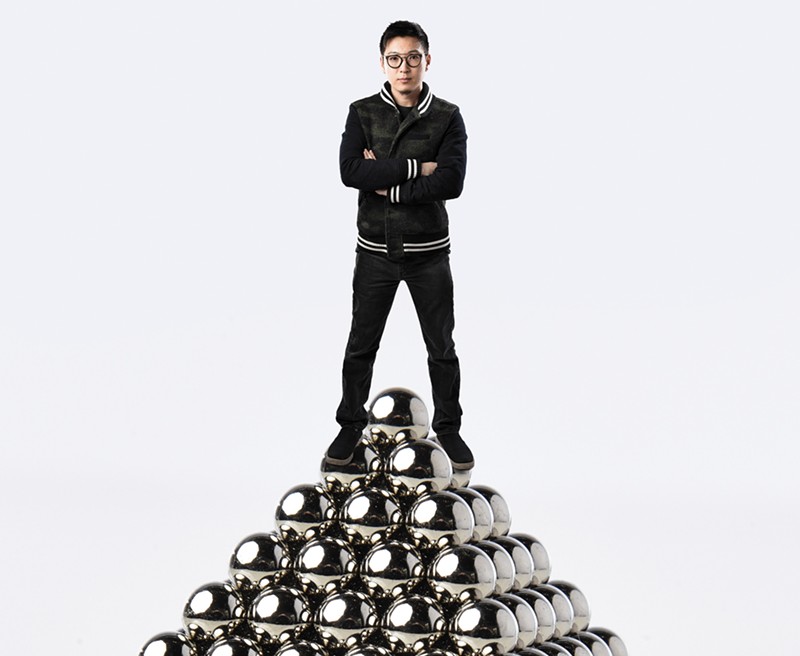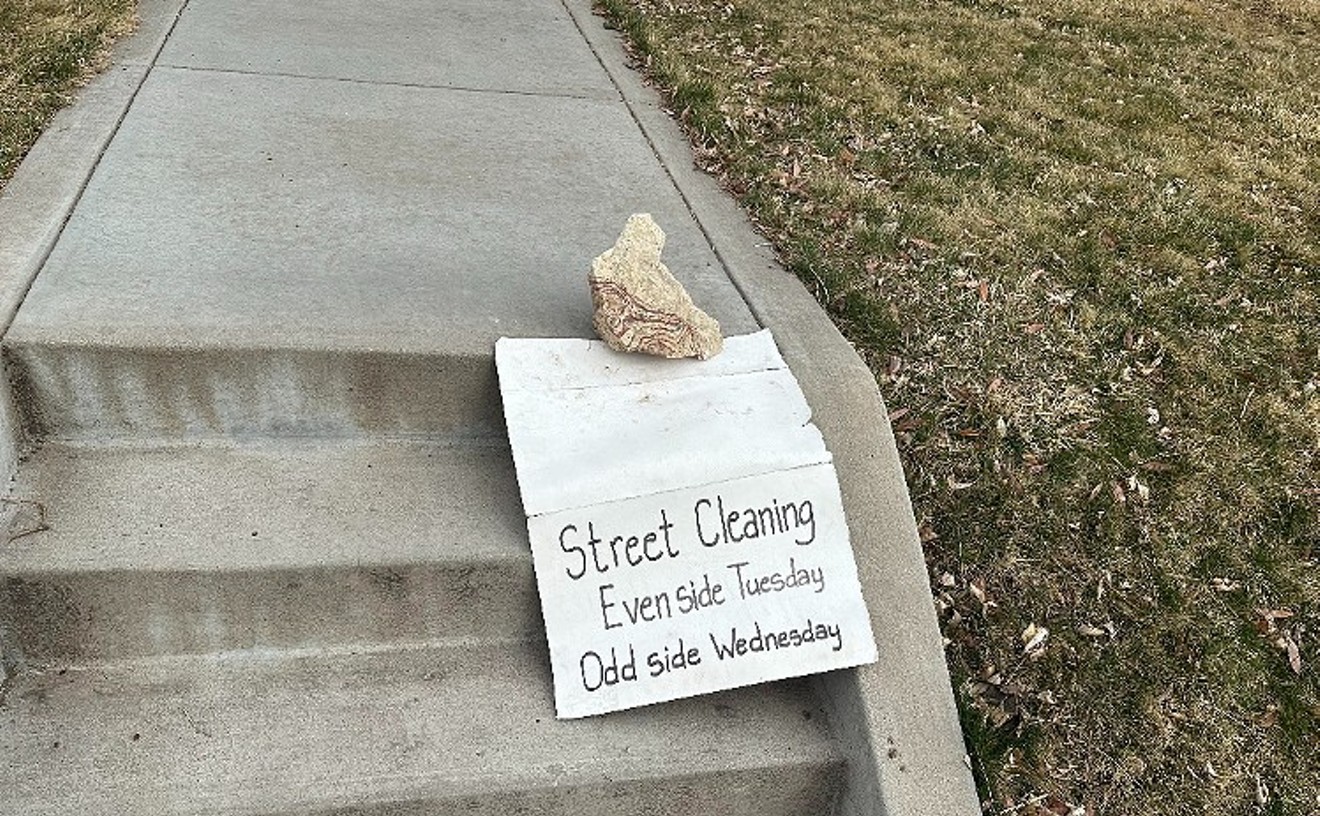Shihan Qu thought he knew a thing or two about small, round magnets and their capacity to attract — not only each other, but artists, scientists and hobbyists, drawn by the magnets’ quirky behavior and simple elegance. What he hadn’t counted on, though, was their ability to attract trouble.
The first sign of trouble arrived on his doorstep six or seven years ago, in the form of a polite, official-looking fellow in a drab suit. Qu was in his early twenties then, a recent graduate of the University of Colorado and already a fledgling entrepreneur, operating his own online company, Zen Magnets, out of his home in Boulder. The man identified himself as a representative of the United States Consumer Product Safety Commission, a federal agency. He said he had a few questions.
Another business owner might have been more suspicious, mindful of the old canard: I’m from the government and I’m here to help you. But Qu figured he had nothing to hide. He invited the man inside. He showed him his office, his website and his magnets — BB-sized rare-earth balls, thirty times more powerful than the typical refrigerator magnet, sold for as little as twelve bucks for a set of 72, and used to make jewelry, complex geometric shapes, free-form sculptures and other kinds of magnet art, or simply for desktop fidgeting and messing around.
The man took notes. He volunteered little about the reasons for his surprise visit. At one point he mentioned that there were possible safety concerns; the CPSC had received reports about children swallowing high-powered magnets like those sold by Zen, with devastating results. Qu pointed out that he didn’t market his magnets as a toy and included a warning on his website: “Can cause serious problems if swallowed. Do not give to kids under the age of 12, and keep them away from pets.”
The man left. Qu set about adding to his website more explicit, stronger warnings about magnet ingestion. But the episode was only the first volley in what would become an all-out assault on small rare-earth magnets, or SREMs, by federal regulators and the Department of Justice. Over the next few months, Qu received voluminous paperwork from the CPSC, inquiring about his operations, his packaging and his suppliers. He received notifications that the agency was contemplating a new rule that would essentially ban the sale of high-powered magnet spheres. He was asked to agree to a “voluntary” recall of his product or face dire consequences.
Qu was a modest operator in a decidedly niche business. In its better years, Zen Magnets sold around 20,000 magnet sets of various sizes, grossing $600,000 in annual revenues — less than 5 percent of the market at its peak. As the pressure from the government increased, much bigger companies than Zen decided to throw in the towel. Most of his friends and advisors urged Qu to do the same.
“You’re up against the federal government,” Qu says. “Every expert tells you you’re not going to make it, don’t try to fight this. If it was just about corporate profits, I would have left the same time everybody else did. But at the time it just felt like — it was angering to me. If I don’t fight this, I’m going to regret it for the rest of my life.”
That decision has plunged Qu into a long-running, cash-draining, bureaucratic cage match that few small business owners would have the audacity, the tenacity or, yes, the balls to endure. He was forced to lay off most of his staff and, at one point, to suspend sales for months. He’s been socked with an absurdly astronomical fine and ordered to destroy part of his stock. He’s devoted considerable time and expense to developing what may be the most elaborate, redundant warnings to be found on any consumer product, and to raising public awareness of the hazards of magnet ingestion, only to be portrayed by the product police as irresponsible and heedless of child welfare.
At the same time, he’s scored some astonishing victories over the CPSC, kicking Goliath’s ass in one venue after another. His refusal to back down led to a rare evidentiary hearing in front of an administrative law judge, Dean Metry, who rejected the agency’s argument that Zen magnets were too dangerous to be offered for sale. A few months later a panel of judges from the Tenth Circuit Court of Appeals — including Neil Gorsuch, soon to be Donald Trump’s first Supreme Court selection — threw out the agency’s new magnet safety standard, agreeing with Zen that the data on ingestion incidents used to support a ban on SREMs was outdated and suspect. And, in a series of broadsides on his website and YouTube blasts, Qu has exposed the agency’s faulty research and conflicting directives — as well as its hypocrisy in waging war on his magnets, while much more commonly available, government-approved household products cause thousands of child injuries and hundreds of deaths every year."Every expert tells you you're not going to make it, don't try to fight this. If I don't fight this, I'm going to regret it the rest of my life."
tweet this
Despite the setbacks, last fall the CPSC approved a “final order” that sets aside Judge Metry’s ruling and requires Zen Magnets to stop selling its high-powered magnets. That set the stage for a showdown in Denver’s federal court, where Zen attorney David Japha is claiming that the order is improper and violates his client’s constitutional right to due process. At a January 4 hearing, Japha told U.S. District Judge Brooks Jackson that Qu’s resources were exhausted and that he would be unable to continue the battle if the final order took effect. Jackson said that he needed time to study the issue, and the CPSC agreed to delay action on the order for another 120 days.
The magnet dispute has sporadically caught the attention of libertarian and conservative groups, who view the CPSC’s zeal to deprive American adults of their shiny magnetic balls as a textbook case of nanny-state overkill. More tellingly, perhaps, the federal crusade has generated criticism from some past and current members of the consumer safety commission itself, who’ve found their colleagues’ obsession with a ban to be baffling and misguided.
“There are a lot of things that the agency could do to address the risks here,” says Nancy Nord, an attorney who was appointed to the CPSC by President George W. Bush in 2005 and stepped down in 2013. “But they have committed themselves to the notion that this needs to be a banned product. Obviously, the commission never anticipated that Mr. Qu would dig in and say, ‘No, this is not right. I’m fighting it.’ And so far his track record is a lot better than theirs.”
As Qu sees it, the fundamental issue in his pyrrhic struggle with the feds has little to do with oppressive government regulations (something that candidate Donald Trump vowed to combat) or standing up for free enterprise. It’s more about embracing common sense and rationality in an age of unreason, championing science and wonder and personal responsibility against forces that thrive on fear and intimidation. It’s not about politics. It’s a choice between living in one America or another.
“People want to make this a left-versus-right thing, when it really shouldn’t be like that,” he says. “We are all generally misrepresented right now.”
Born in Beijing, Shihan Qu arrived in Colorado at age three. He grew up in Fort Collins and Denver and attended Cherry Creek High School. In 2009 he was finishing up his studies in mechanical engineering at CU when he ordered his first set of rare-earth magnets online.
He took them on a camping trip in the mountains and couldn’t put them down. They were compact and mysterious, astonishingly strong, a tactile experience of infinite sides and endless forms. “They made me feel very at peace, which is why I called them Zen Magnets,” he explained in a 2014 Westword interview.
In “a moment of awe and lucidity,” as he later put it in a very personal email to the impersonal functionaries of the CPSC, he decided to launch a company centered on magnets. Qu and his then-girlfriend started Zen with an $800 investment in magnets imported from China. Several other American companies had the same idea around the same time; one, Bucky Balls, quickly came to dominate the industry, selling millions of magnet sets through retailers and online over the next three years. Qu tried to position his company apart from the rest, seeking out the highest-quality SREMs that he could find and urging the manufacturer to work on even tighter production tolerances.
He also demonstrated a flair for canny, often irreverent marketing. “Never Let Go of Childhood Wonder,” an early, rapid-fire YouTube video showing Qu manipulating his magnets into a dazzling procession of cubes, stars, bracelets and other shapes, drew millions of views. On his website he went after Bucky Balls like a horse fly tormenting a Clydesdale, asserting that the industry giant’s magnets couldn’t match Zen’s coating, strength or size consistency. When one of the founders of Bucky Balls threatened to sue, leaving a voicemail that demanded that Qu “cut that noise out” or else, Qu ridiculed him in a gonzo video that featured a withering ball-to-ball demonstration of Zen’s superior workmanship. A tagline at the end urged, “Help fight the bully by spreading this video.”
But both companies soon had a bigger bully to worry about.
In early 2010, just as the rare-earth magnet craze was beginning to take off, the Consumer Product Safety Commission received its first report of an ingestion incident; a nine-year-old boy had swallowed seven magnets while attempting to use them to simulate lip and tongue piercings. The boy passed the magnets as a single mass, but subsequent cases weren’t as fortunate. The magnets’ inclination to seek out each other led to intestinal pinching and obstructions, stomach and bowel perforations and other serious complications; surgery was often required to remove the magnets, and sometimes damaged tissue had to be taken out, too.
By late 2011, the CPSC was aware of 22 ingestion incidents and issued a public-safety alert. The victims tended to fall into two groups: children under the age of five, who came upon loose magnets and popped them into their mouths like candy, or tweeners fooling around with make-believe body piercings. Qu might have intended his magnets to help adults embrace childhood wonder, but the CPSC regarded the balls as “intensely appealing to children due to [their] tactile features, small size, and highly reflective, shiny, and colorful metallic coatings.”
A few years earlier, the Chicago Tribune had scored a Pulitzer Prize by exposing how an understaffed CPSC had been slow to respond to reports of children injured from swallowing magnets that broke loose from a construction toy. The agency had since received a boost in funding and enforcement powers and was determined to take swift action against the new magnet hazard. The first steps involved alerting the public and working with the industry to develop stiffer warnings; but as the injury reports continued, the campaign quickly escalated.
With surprising speed, the agency nudged retailers to stop carrying SREMs, then started herding the major suppliers toward a voluntary recall. Seeking to avoid a ruinous legal battle with the government, most readily agreed. Bucky Balls hung on for a few months, blustering defiance, then quietly closed up shop. By the end of 2012 there was only one American company still operating: Zen Magnets.
Qu had briefly considered joining the exodus, but the agency’s blanket condemnation of his magnets rankled him. Some of his competitors had sold magnets in toy stores or promoted them as body art; he hadn’t. True, he also offered a line called Neoballs, which came in bright colors and were arguably “intensely appealing” to children, but he also had put more of an emphasis on warnings and safety than many other companies. At one point he even turned to selling his magnets through Denver marijuana dispensaries and head shops, underscoring the adult nature of their audience.

Zen Magnets attorney David Japha says the government’s crusade against his client hasn’t made the public any safer.
Courtesy of David Japha
“Where’s the middle ground? I’m willing to work for that middle ground. I’ve been open to suggestions, I’ve been willing to implement any warnings the CPSC wants. They just brick-wall and say no.”
David Japha, Qu’s attorney, says the agency’s “zero tolerance” approach to the magnet issue has been frustrating. “They advertise themselves as wanting to be educators, working with businesses and consumers,” he says. “But if you’re a product manufacturer, you toe the line. They will not work with you. They kept rejecting our fixes.”
The standoff led to the first CPSC lawsuit against a product to actually go to an administrative hearing in more than a decade. According to the complaint filed by the CPSC attorneys, there’s simply no “fix” — no warning, no preventive packaging, no restrictive marketing plan — adequate to prevent the magnets from ending up in the digestive tracts of children. Over time magnets could get separated from the set and passed around among kids, and the warning labels on the box wouldn’t go with them. “The magnets themselves display no warnings,” the complaint observes, “and the small size of the individual magnets precludes the addition of warnings.”
Qu thought the line of reasoning was ridiculous — would microscopic print on five-millimeter balls actually be an improvement? — and the data used to support it even more tenuous. Out of the dozens of ingestion reports the CPSC received over a span of five years, there were only two that the agency had traced back to his product: a toddler and a fourteen-year-old girl, both in Florida. Both had undergone surgery and apparently made full recoveries. And the case of the fourteen-year-old — who’d been given six magnets by a friend, had been told by her mother to get rid of them but had kept two and accidentally swallowed them — had occurred in 2013, months after the agency filed its complaint against Zen Magnets.
Yet it was the agency’s position that there were many other incidents in which the product brand had not been ascertained, and Zen could have been involved in some of those cases, too. Nothing would satisfy the CPSC short of the company’s complete obliteration. The campaign was actually a two-pronged effort: At the same time that the commission was seeking to force Zen to stop selling SREMs through administrative action, it was also moving to establish a new rule that would prohibit all such sales.
"Zero tolerance is just not normal. It's not how we live."
tweet this
The move was unprecedented — and troubling to many observers. The CPSC was seeking to implement a product ban that basically targeted the only American company still in the market, Zen Magnets. And doing so while also going after Zen individually was problematic because the five-member commission was also the entity that heard appeals stemming from actions taken by its enforcement division. How could the members pretend to be impartial when hearing any appeal concerning Zen, if they had already declared that its magnets were too dangerous to be sold?
“The situation here is particularly unusual in that the only magnet sets that are practically affected by the new standard are those already involved in the adjudication,” wrote Ann Marie Buerkle, the CPSC acting chair, in a statement explaining her decision to abstain from the vote on the new rule. “To issue a final rule outlawing the same product that is the subject of the adjudication would seem to be the ultimate prejudgment.”
Her colleagues on the commission had no such qualms. In the fall of 2014 they voted unanimously to ban high-powered magnet balls.
But the fight was just getting started.
Opening a 216-count package of Zen magnets these days requires you to wade through more cautions, disclaimers, red alerts and hazard advisements than you’ll find on your average gas-powered chainsaw rental agreement.
First you have to remove a tough metallic sticker from the cardboard container, which brings you face-to-face with a warning on the end flap that neodymium magnets are not for children, that swallowing them can cause serious injury or death, and that “seal removal implies assumption of risk.” Under the flap are more exhortations: “Intelligence Required” and “Get Lost in the Magnets — Don’t Get the Magnets Lost in You.”
Inside is a bamboo box. To open it, you have to peel off a label that explains once again the ingestion hazard (“swallowing magnets belongs on your don’t do list, along with: breathing water, drinking poison, or running into traffic”) and declares, “Magnets must be respected, but need not be feared.” Inside the box are more warnings included in an instruction booklet, and even more warnings imprinted on the plastic bag containing a velvet pouch full of magnets. Short of etching a skull and crossbones on each magnet, the message couldn’t be any clearer.
Sitting in a conference room a floor above his current office in Aurora, Qu watches me grapple with the sticker, trying various tools to slice it open. He shakes his head. The CPSC has expressed no interest in the improvements he’s made in his packaging in the past few years, he explains: “This is what they’re trying to get rid of, but they don’t even know what it is. They’ve never seen it.”
On occasion the CPSC has made note of the warnings and alerts Qu has posted on his website, taking exception to their snarky tone. (Example: “OMFG READ ME This is serious. The grumpy CPSC is about to BAN magnet spheres in the US because they are an ingestion hazard. They don’t trust that you are capable of understanding and following warnings. Prove them wrong, or we all can’t have nice magnets.”) Such warnings are perhaps more effective because they are more entertaining than the usual lawyer-drafted disclaimer. But to the agency, Qu’s approach to informing his customers about magnet hazards is another reason to ban his product; his choice of words, their complaint contends, “undermines the credibility and effectiveness of those warnings, which, in turn, may cause consumers to disregard the warnings.”“Every expert tells you you’re not going to make it, don’t try to fight this. If I don’t fight this, I’m going to regret it for the rest of my life. Zero tolerance is just not normal. It’s not how we live."
tweet this
The agency’s huffiness on the warning issue is just one element of the deep divide that separates Qu from the people weighing his fate. Qu is convinced that the regulators just don’t get his magnets, which are much more popular with millennials than middle-aged lawyers and political appointees. “I imagine the commission and their staff don’t play with toys anymore,” he says. “They don’t experiment and explore.”
One of the factors that the CPSC is supposed to take into account when evaluating safety issues is the “utility” of the product in question — that is, whether it serves a useful, legitimate purpose. The commission’s official position is that SREMs have low utility.
“They looked at this product,” former commissioner Nord says, “and thought, ‘Oh, it’s a silly adult desk toy. What benefit does that have to society?’ The educational benefits are really quite significant, but they were never considered by the agency.”

Utah State University physics professor Boyd Edwards has testified to the magnets’ usefulness in teaching physics and chemistry.
Courtesy of Boyd Edwards
Edwards was first introduced to SREMs almost six years ago, when his college-age son brought home a set of Bucky Balls. “I was immediately fascinated by them,” Edwards recalls. He taught electromagnetism, but the sneaky polarities of the spheres invited him to consider magnetic configurations that hadn’t occurred to him before; for example, the magnets would line up easily enough into a chain until you broke them into two chains, which would then repel each other like bar magnets of the same polarity — until brought into close proximity, when they would realign and attract.
He went online and discovered that Bucky Balls was going out of business. He soon established a relationship with Zen, working with Qu directly to help him improve the tolerances of his product. He has since published three peer-reviewed papers on the magnets’ properties, won a video contest sponsored by Zen with an assemblage of Platonic solids using magnets, and presented how-to tutorials for more complex designs on his own YouTube channel, including a 16,900-magnet version of a Sierpinski Tetrahedron, a harmonious arrangement of pyramids within pyramids.
He’s also served as an expert witness on Qu’s behalf, testifying about using magnets in a classroom setting to illustrate principles of physics or chemistry. “They are valuable in my teaching and as a medium of artistic expression,” he says. “It’s something we need to keep around. I think it’s a case of government overreach to try to ban a product like this.”
Other educators have also come forward in the Zen litigation to affirm that the magnets are useful for teaching geometry concepts, the formation of crystal lattices, molecular structures and more. One physicist at Los Alamos National Laboratory explained that he uses magnet spheres in his research on computational meshes, as an aid to help him visualize meshes “with dimensionalities greater than three.”
The CPSC received more than 2,500 public comments on the magnet issue — far more than it had received on any previous rule-making process, with more than 90 percent of the commenters opposed to the ban. In addition, Qu commissioned a national poll that indicated little public support for a magnet ban — far less, in fact, than the number of respondents who agreed with banning guns, tobacco, alcohol or cars.
But public sentiment wasn’t much of a factor in the CPSC’s decision to outlaw the magnets. What seemed to matter most to the commissioners was the anecdotal evidence concerning grim child injuries. The agency had direct reports of around a hundred ingestion incidents over a five-year period. Through statistical projections, the agency estimated that, between 2009 and 2013, there had been 2,900 ingestion incidents resulting in emergency-room visits. And one of those incidents had resulted in a death: In 2013, nineteen-month-old Annaka Chaffin had swallowed seven magnet balls from a necklace that a sibling brought home from school. Her illness had been misdiagnosed as the flu; her perforated bowel wasn’t discovered until it was too late.
The Chaffin case was invoked frequently by commission members to justify the ban. At one public hearing, then-chairman Elliot Kaye read aloud an email from the girl’s aunt and denounced “the hidden and devastating hazard of magnet ingestion.” His emotional speech included several nods to members of Chaffin’s family in attendance.

After a federal judge ordered the destruction of 400,000 of Qu's magnets, last April workers fed the offending balls in to an industrial furnace in north Denver.
Courtesy of Zen Magnets
No one could take issue with Kaye’s outrage at one family’s tragic loss. But Qu suspected there was something very wrong with the data the CPSC had compiled suggesting that magnet spheres were responsible for thousands of child injuries. He poked around the numbers, deposed the agency’s epidemiology director, and concluded that the claim was “total bullshit.”
What the CPSC had done in its projections was lump together ingestion incidents of SREMs with those involving a range of other items, such as magnetic marbles or refrigerator magnets, that fit any one of several key search terms — including “rare,” “round” and “strong.” That vastly inflated the annual number of ER visits attributed to rare-earth magnetic spheres, to around 570 a year. If you apply the same methodology to the three years before SREMs were on the market, you come up with 650 ER visits a year. In other words, there were more magnet-ingestion incidents before the offending product even existed.
Putting aside the badly flawed statistical projections, the hard data of actual incident reports told a different story. The CPSC had reports of thirteen ingestions in 2010, nineteen in 2011, and 52 in 2012. Then the numbers decreased to thirteen in 2013, including the one fatality, and only two incidents in 2014. The sharp drop could be largely attributed to the agency’s pressure on the industry, including Bucky Balls’ closing up shop at the end of 2012; as magnet sales dropped dramatically, so did the number of ingestion incidents. But Qu believed the decline was also an indication that his increasingly stringent warnings were working. In any event, two incidents in a year was a far cry from the thousands of ER visits caused by trampolines each year, or the 3,500 ingestions of button-cell batteries each year, or the havoc wrought by tricycles, unattended swimming pools, household-cleaning supplies, Tide pods or balloons (the most common choking hazard of all toys).
The fact that a product can be misused isn’t considered an adequate reason to brand it as defective under the Consumer Product Safety Act; if misuse justified prohibition, the handgun and booze industries would be in big trouble. “Balloons, ATVs, trampolines — they have worked with companies to try to make them safer,” notes Japha. “Zero tolerance is just not normal. It’s not how we live.”
“Why is the CPSC spending all these resources going after one of the few companies in the United States that’s trying to market this product responsibly?”
tweet this
Some products are defective, of course, even if used properly. (Exhibit A: the Worm Gett’r, a gizmo that was supposed to force earthworms to the surface with electric shocks; the device and its imitators caused more than two dozen electrocution deaths before it was found to have a “patent product defect.”) Others, like balloons or small batteries, can be misused by children, but their usefulness is deemed to outweigh the risk of injury. In the case of the magnet balls, though, the agency considered the product to be not terribly useful and subject to “reasonably foreseeable misuse,” to an extent that no warnings would be sufficient.
In 2016, that line of reasoning was completely rejected by the administrative law judge, Dean Metry, who heard the agency’s case against Zen Magnets. Metry decided that the magnets’ utility was much higher than the agency acknowledged. He also ruled that while SREMs marketed to children without appropriate warnings are “substantial product hazards,” the agency hadn’t proved that the public needed to be protected from Qu’s magnets, which were sold to adults with a bevy of warnings. The risk of injury from SREMs, he concluded, “is significant only when [the product is] advertised for oral ingestion and/or when combined with a lack of parental supervision.”
The ruling was a rare and stunning rebuke of the agency’s position. But for Qu, it was largely a hollow victory. The agency’s attorneys immediately set about appealing Metry’s order — an appeal that would be heard by the commissioners themselves, who’d already issued a rule banning SREMs. Technically, Zen was still in business pending the outcome of the appeal, but Qu’s inability to import the banned spheres forced him to suspend sales and shut down his warehouse. He went from twelve employees to one, operating out of a spare bedroom.
On top of that, Qu was also fighting a side battle that threatened to consume the whole show. In an effort to alleviate his supply problems, he’d acquired magnets from a former competitor, who was in the process of negotiating a recall. The magnets came from the same factory in China that Qu used for his Neoballs, but the CPSC sued him, on the grounds that it was illegal to resell a recalled product. (If the magnets had been shipped back to China and commingled with other magnets at the factory before Qu bought them, there would have been no issue with the purchase, which occurred before the ban took effect.) U.S. District Judge Christine Arguello ordered Zen to destroy 400,000 magnets and fined the company $5.5 million.
Qu did not have $5.5 million. He was close to being broke. The fine was whittled down to $10,000. Last spring Qu stood beside an industrial furnace in north Denver and watched the offending magnets roasted into dull, powerless metal peas while a videographer captured the burn.
Six months before the magnet inferno, the Tenth Circuit Court of Appeals handed Qu another unlikely triumph over the regulators. The circuit judges threw out the ban on magnet sales, ruling that the data the CPSC had relied upon to justify its prohibitive “magnet safety standard” was outdated and insufficient. They also found that the commission had failed to evaluate the cost to consumers of such a ban, including the loss of the magnets as “scientific and mathematics education and research tools.”
It was the first court-ordered reversal of a federal product ban in decades. With no specific magnet standard in place, it meant that Zen Magnets could resume taking orders for high-powered SREMs. And so could anyone else. Before long, new or rejuvenated companies began to surface, hawking magnets on Amazon or through stores such as Brookstone. A few referred to their products as Bucky Balls, although the original purveyor of Bucky Balls no longer existed.
“We fought the regulation, but these guys are now selling because of our work,” Qu observes. “Some of them just stopped selling, and now they’re selling again.”
The irony of the situation wasn’t lost on him. Some of the new sellers were offering magnets with no warnings whatsoever about the ingestion hazard. Meanwhile, the company that had the strongest warnings in the industry was now the only one under attack by the CPSC. Despite the Tenth Circuit ruling, the agency continued to doggedly pursue its administrative action against Zen, culminating in the final order issued by the commission last fall, directing the company to stop selling its SREMs.
Overruling Metry’s decision, the commissioners found that Zen’s magnets “do not constitute a necessity” for consumers. In fact, their “foreseeable misuse” — the risk that children would swallow them, regardless of whatever warnings were offered — made them defective. The order required the company to not only stop sales, but make an effort to recall every high-powered magnet it had ever sold and notify consumers of the dangers.
The agency’s inflexible position, coming on the heels of one reversal after another, struck former commissioner Nord as bizarre — especially since the agency has taken no action against the other companies now selling magnets with no warnings at all. “Why is the CPSC spending all these resources going after one of the few companies in the United States that’s really trying to do the right thing and market this product responsibly?” she asks.
CPSC communications director Joe Martyak responds that the agency has the authority to impose recalls for unsafe products sold in the United States, whether by domestic or foreign companies. But he declines to elaborate on any possible enforcement actions at present against other magnet companies, saying he can’t comment on ongoing investigations. He adds that the CPSC is in the process of “gathering data” for development of a new magnet safety standard.
But at the moment no such standard exists — a point Japha stressed in his argument before Judge Jackson. “If our motion today is denied, and Mr. Qu has to shut his company down, that will not protect the public,” he said. “You can go to Brookstone or Amazon and get [magnets] today without locks or warnings. ... This company is the last one standing in terms of legitimacy.”
Jackson, too, seemed puzzled that the agency was devoting so much energy to its administrative action against Zen. He wrestled with the question of how many injuries the agency would have to substantiate to justify a ban.
“Even one incident with these horrific injuries is enough for the commission to proceed [against Zen],” insisted Roger Gural, a trial attorney for the Department of Justice.
Jackson wasn’t so sure. He mused on what would happen if he took the same zero-tolerance approach to his job, sentencing every criminal defendant to the maximum sentence allowable by law in order to protect the public. “But we don’t do that,” he quickly added.
Jackson agreed that Zen would suffer “irreparable harm” if he didn’t rule in the company’s favor. At the same time, he suggested that whatever he decided, Qu’s quixotic crusade against the feds could not go on much longer.
“Much as I would be loath to put your client out of business, that’s not of as much interest to me as harming kids,” he told Japha. “He’s smart enough to know this is not going to be a career for him. He’s fighting a losing battle here. He counts himself as a man who stood up to the big bad bully. Sometimes the better course of valor is to make a different product.”
Actually, Qu has ventured into other products. He started selling micro-magnets, half the size of his trademark balls and much weaker in magnetic force, as a way of raising money while the ban on five-millimeter SREMs was in effect. The result was encouraging enough that he partnered with Craig Zucker, one of the founders of Bucky Balls, in launching a new company, Speks, that offers “office toy and stress relief” magnets that are too small and weak to attract the wrath of the CPSC. (Another irony: While Zen magnets now appear on at least one “dangerous product” list online, Speks has made “hot gadget” and trendy gift lists in publications from Forbes to Parade.)
But while Speks is thriving, Qu says he’s playing a less active role in the venture and isn’t interested in a career in micromagnets. (Zucker didn’t respond to a request for comment.) The balls can’t be manipulated as easily as bigger ones, he notes, and they’re not as useful for large or intricate constructions. They’re not Zen magnets.
In Jackson’s courtroom, Qu took the stand briefly to defend his magnets and their right to exist. He showed an excerpt from the “Never Let Go of Childhood Wonder” video and tried, without success, to get the judge to examine the current packaging of his product and all its warning labels. He spoke rapidly and quietly, prompting some confusion from Jackson and reminders from his attorney to slow down and speak up.
Later, in the Aurora office he now shares with three employees, he’s asked if his epic battle with the government has been worth it.
“I feel like this company faced death so many times that it doesn’t have the same emotional impact anymore,” he says. “I didn’t expect to make it this far.”
He has no idea if Zen Magnets will survive or if he will move on to some other challenge. Maybe he’ll get involved in a virtual-reality arcade, he suggests, or something in robotics. Whether he wins or not, he badly wants to see the CPSC lose.
“I do feel they should be humbled a bit,” he says. “They should be taught the edges of their power. I feel like it’s a mass overreach in many ways, and that karma needs to come back and bite them for ignoring the will of the people.”















